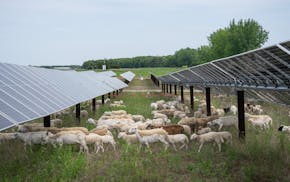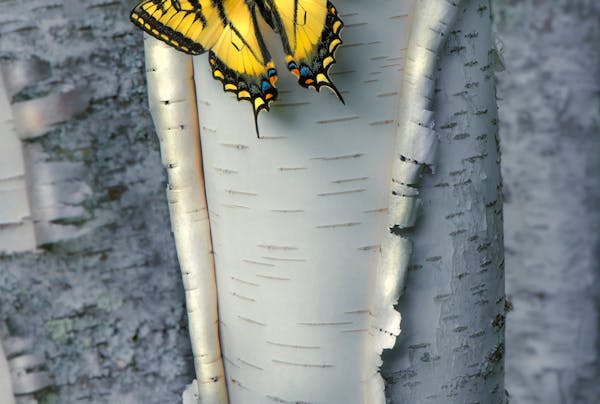LUVERNE, Minn. – Beaver Creek meanders across Touch the Sky Prairie, cascading at one location into a sublime, stair-step waterfall.
Wild bison once roamed this quartzite ridge, grazing in big bluestem grass, rubbing against immense rock outcroppings and looking out at lower land in every direction. Burrowing owls lived here along with river otters and monarch butterflies. Bobolinks and yellow-striped dickcissels returned each spring to fill the air with birdsong.
"It's about a spiritual experience for me … a deep feeling I get when I'm out here," said Jim Brandenburg, a National Geographic nature photographer who has helped preserve the area as a living, ecological museum.
Brandenburg, who was born here when wire fences, farm buildings and crop machines dotted the hillsides, returned last month to showcase Rock County's 1,000-acre conservation gem for the Governor's Pheasant Hunting Opener. The land, located 5 miles north of Interstate 90, is now the second-largest segment of the Northern Tallgrass Prairie National Wildlife Refuge.
The 18-year-old project is being assembled around rare pieces of remnant prairie in a project area covering 48 western Minnesota counties and 37 northwestern Iowa counties. The buffalo aren't coming back, but land managers are restoring the landscape with plant seeds that will encourage the return of lost prairie wildlife. At Touch the Sky, the number of native plant species has increased from 120 to 170.
Todd Luke, Windom area district manager for the U.S. Fish & Wildlife Service, said each segment is a biological snapshot into the past and Touch the Sky is a priority for continued expansion.
"It's kind of a forgotten part of the state down here," Luke said during a tour one day before local pheasant hunters arrived at the refuge to kick-start the 2018 ringneck season.
For Dakota Sioux people, the high, rolling terrain with vistas of up to 20 miles long was the site of vision quests. Its raw beauty now draws hikers, photographers, birders, students, tour groups, archaeologists and hunters.
Unplowed prairie once covered about 25 million acres of what is now western Minnesota and northwestern Iowa.
Today, rare remnants total only 300,000 acres of untouched grassland wildlife habitat from the Canadian border to Des Moines. The tallgrass prairie refuge project aims to preserve 77,000 of those acres — 13.5 percent already secured by land acquisitions and permanent easements.
Luke said the Fish & Wildlife Service is actively scouting for additions to Touch the Sky and is in the process of adding a new chunk.
"It's so crucial that landowners are willing to sell," he said.
Saving the terrain
In places like Luverne, rows of wind turbines are posing a new threat to what was once the continent's largest ecosystem. Brandenburg said he's been moved by the local community's embrace of the area's natural history and the ongoing effort to expand Touch the Sky.
Rock County anchors the southwest corner of Minnesota with geology that includes some of the state's richest soil. But random outcroppings of exposed rock saved the county's highlands from the plow. The movement to permanently save the terrain started in 1999 with the formation of the Brandenburg Prairie Foundation to educate, promote, preserve and expand native prairie in southwestern Minnesota.
"The project has shown that people in the right frame of mind have potential to do good things," said Brandenburg, who opened an art gallery in Luverne that dedicates its proceeds to the effort. "I think about those feelings when I'm out here."
There's been grants from the Blandin Foundation and Southwest Minnesota Foundation. Ducks Unlimited, Pheasants Forever, the Nature Conservancy and Audubon also have been active in northern tallgrass prairie projects.
The mainstay for the eco-region, however, has been money from state taxpayers and proceeds from the Minnesota lottery.
The Outdoor Heritage Fund, which was created under the Legacy Amendment, has made nine appropriations since the early 2000s to Northern Tallgrass Prairie projects totaling $20.1 million.
Another $1.3 million benefiting the tallgrass prairie has arrived in pieces via the Minnesota Environment and Natural Resources Trust Fund.
Tony Kennedy • 612-673-4213

Why now might be the best time to make a deal on boats, ATVs and other powersports
Lupine is starting to bloom in Minnesota. Here's where to find it.

Xcel lets loose a small army of hungry sheep to keep its solar farm in order

Anderson: In early June, Minnesota fish are begging to be caught. Won't you help?

